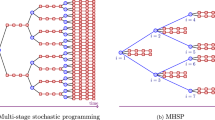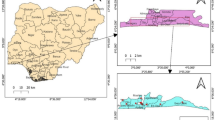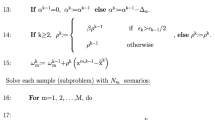Abstract
In this study, we establish a bilevel electricity trading model where fuzzy set theory is applied to address future load uncertainty, system reliability as well as human imprecise knowledge. From the literature, there have been some studies focused on this bilevel problem while few of them consider future load uncertainty and unit commitment optimization which handles the collaboration of generation units. Then, our study makes the following contributions: First, the future load uncertainty is characterized by fuzzy set theory, as the various factors that affect the load forecasting are often assessed with some non-statistical uncertainties. Second, the generation costs are obtained by solving complicated unit commitment problems, rather than approximate calculations used in existing studies. Third, this model copes with the optimizations of both the generation companies and the market operator, where the unexpected load risk is particularly analyzed by using fuzzy value-at-risk as a quantitative risk measurement. Forth, a mechanism to encourage the convergence of the bilevel model is proposed based on fuzzy maxmin approach, and a bilevel particle swarm optimization algorithm is developed to solve the problem in a proper runtime. To illustrate the effectiveness of this research, we provide a test system-based numerical example and discuss about the experimental results according to the principle of social welfare maximization. Finally, we also compare the model and algorithm with conventional methods.



Similar content being viewed by others
Abbreviations
- \(m\) :
-
Index of generation company
- \(M\) :
-
Number of total generation companies
- \(j\) :
-
Index of each generation unit
- \(t\) :
-
Index of each scheduling period
- \(T\) :
-
Number of total scheduling periods
- \(N_{m}\) :
-
Number of units in company \(m\)
- \(\textit{AP}_{t,-}^{m}\) :
-
Empirical lower bound of \(\textit{AP}_{t}^{m}\)
- \(\textit{SC}_{j_{m}}\) :
-
Cold/hot star-up cost of unit \(j_{m}\)
- \(a_{j_{m}},b_{j_{m}},c_{j_{m}}\) :
-
Cost function coefficients of unit \(j_{m}\)
- \(P_{j_{m}}^{\textit{max}}\) :
-
Maximal generation capability of \(j_{m}\)
- \(P_{j_{m}}^{\textit{min}}\) :
-
Minimal generation constraint of \(j_{m}\)
- \(P_{m}^{\textit{max}}\) :
-
Maximal capability of company \(m\)
- \(T_{j_{m},\textit{up}}\) :
-
Minimal ‘on’ hours of unit \(j_{m}\)
- \(T_{j_{m},\textit{down}}\) :
-
Minimal ‘off’ hours of unit \(j_{m}\)
- \(U_{j_{m}}\) :
-
Number of hours unit \(j_{m}\) is required to be on at the start of the planning period
- \(D_{j_{m}}\) :
-
Number of hours unit \(j_{m}\) is required to be off at the start of the planning period
- \(A_{j_{m}}\) :
-
Minimal value of \(U_{j_{m}}\) and T
- \(B_{j_{m}}\) :
-
Minimal value of \(D_{j_{m}}\) and T
- \(\textit{DR}_{j_{m}}\) :
-
Maximal downward ramp rates of \(j_{m}\)
- \(\textit{UR}_{j_{m}}\) :
-
Maximal upward ramp rates of \(j_{m}\)
- \(\widetilde{L}_{t}\) :
-
Forecasted fuzzy load of period \(t\)
- \(\textit{LB}_{t}\) :
-
Lower bound of \(\widetilde{L}_{t}\)
- \(\textit{UB}_{t}\) :
-
Upper bound of \(\widetilde{L}_{t}\)
- \(\widetilde{E}_{m}\) :
-
Estimated fuzzy target profit of GC \(m\)
- \(\widetilde{\textit{LC}}\) :
-
Estimated fuzzy target cost of MO
- \(\textit{RB}\) :
-
Reservation budget of a MO
- \(\textit{CT}_{j_{m}}(G_{t}^{j_{m}})\) :
-
Cost function of unit \(j_{m}\) with output \(G_{t}^{j_{m}}\)
- \(F^{\prime }_{m}\) :
-
Cost function of company \(m\)
- \(F_{m}\) :
-
Upper level objective function
- \(f\) :
-
Lower level objective function
- \(\textit{AP}_{t}^{m}\) :
-
Average bidding of company \(m\) in \(t\)
- \(\textit{HP}_{t}\) :
-
Higher payment for unexpected load
- \(G_{t}^{j_{m}}\) :
-
Real generation of unit \(j_{m}\) in period \(t\)
- \(u_{t}^{j_{m}}\) :
-
On/off (1/0) state of unit \(j_{m}\) in period \(t\)
- \(x_{t}^{j_{m}}\) :
-
Startup action at time \(t\) of generator \(j_{m}\)
- \(y_{t}^{j_{m}}\) :
-
Shutdown action at time \(t\) of generator \(j_{m}\)
- \(P_{t}^{m}\) :
-
Generation of company \(m\) in period \(t\)
- \(P_{t}\) :
-
Total generation of all companies in \(t\)
- \(\widetilde{\textit{UL}}_{t}\) :
-
Unexpected load of period \(t\)
- \(R_{t}^{m}\) :
-
Spinning reserve of \(m\) in period \(t\)
- \(\textit{ULC}_{t}\) :
-
Unexpected load cost of period \(t\)
- \(\textit{UMCP}_{t}\) :
-
Unified market clearing price of period \(t\)
References
Bianco, L., Caramia, M., & Giordani, S. (2009). A bilevel flow model for hazmat transportation network design. Transportation Research Part C, 17(2), 175–196.
Blanco, R. F., Arroyo, J. M., & Alguacil, N. (2012). A unified bilevel programming framework for price-based market clearing under marginal pricing. IEEE Transactions on Power Systems, 27(1), 1446–1456.
Bracken, J., & McGill, J. (1973). Mathematical programs with optimization problems in the constraints. Operations Research, 21(1), 37–44.
Candler, W., Fortuny-Amat, J., & McCafl, B. (1981). The potential role of multilevel programming in agricultural economics. American Journal of Agricultural Economics, 63(6), 521–531.
Carrion, M., Arroyo, J. M., & Conejo, A. J. (2009). A bilevel stochastic programming approach for retailer futures market trading. IEEE Transactions on Power Systems, 24(3), 1446–1456.
Christie, R. D., Wollenberg, B. F., & Wangensteen, I. (2000). Transmission management in the deregulated environment. Proceedings of the IEEE, 88(2), 170–195.
Colson, B., Marcotte, P., & Savard, G. (2007). An overview of bilevel optimization. Annals of Operations Research, 153(1), 235–256.
Duffie, D., & Pan, J. (1997). An overview of value-at-risk. Journal of Derivatives, 4(3), 7–49.
Hong, T., & Wang, P. (2014). Fuzzy interaction regression for short term load forecasting. Fuzzy Optimization and Decision Making, 13(1), 91–103.
Juste, K., Kita, H., & Tanaka, E. (1999). An evolutionary programming solution to the unit commitment problem. IEEE Transactions on Power Systems, 14(4), 1452–1459.
Kennedy, J., & Eberhart, R. (1995). Particle swarm optimization, In: Proceedings of the 1995 IEEE international conference on neual networks, IV, pp. 1942–1948.
Lan, Y. F., Zhao, R. Q., & Tang, W. S. (2011). A bilevel fuzzy principal-agent model for optimal nonlinear taxation problems. Fuzzy Optimization and Decision Making, 10(3), 211–232.
Liu, B., & Liu, Y. K. (2002). Expected value of fuzzy variable and fuzzy expected value models. IEEE Transactions on Fuzzy Systems, 10(4), 445–450.
Ostrowski, J., Anjos, M. F., & Vannelli, A. (2012). Tight mixed integer linear programming formulations for the unit commitment problem. IEEE Transactions on Power Systems, 27(1), 39–46.
Peng, J. (2013). Risk metrics of loss function for uncertain system. Fuzzy Optimization and Decision Making, 12(1), 53–64.
Saber, A. Y., Senjyu, T., Miyagi, T., Urasaki, N., & Funabashi, T. (2006). Fuzzy unit commitment scheduling using absolutely stochastic simulated annealing. IEEE Transactions on Power Systems, 21(2), 955–964.
Takriti, S., Birge, J. R., & Long, E. (1996). A stochastic model for the unit commitment problem. IEEE Transactions on Power Systems, 11(2), 1497–1508.
Wang, B., Li, Y., & Watada, J. (2011). Re-scheduling of unit commitment based on customers’ fuzzy requirements for power reliability. IEICE Transactions on Information and Systems, E94–D(7), 1378–1385.
Wang, B., Li, Y., & Watada, J. (2013). Supply reliability and generation cost analysis due to load forecast uncertainty in unit commitment problems. IEEE Transactions on Power Systems, 28(3), 2242–2252.
Wang, B., Wang, S., & Watada, J. (2011). Fuzzy portfolio selection models with value-at-risk. IEEE Transactions on Fuzzy Systems, 19(4), 758–769.
Wang, S., Watada, J., & Pedrycz, W. (2009). Value-at-risk-based two-satge fuzzy facility location problems. IEEE Transactions on Industrial Informatics, 5(4), 465–482.
Wu, X. L., & Liu, Y. K. (2012). Optimizing fuzzy portfolio selection problems by parametric quadratic programming. Fuzzy Optimization and Decision Making, 11(4), 411–449.
Yuan, X., Nie, H., Su, A., Wang, L., & Yuan, Y. (2009). An improved binary particle swarm optimization for unit commitment problem. Expert Systems with Applications, 36(4), 8049–8055.
Zhang, G., Zhang, G., Gao, Y., & Lu, Jie. (2011). Competitive strategic bidding optimization in electricity markets using bilevel programming and swarm technique. IEEE Transactions on Industrial Electronics, 58(6), 2138–2146.
Zimmermann, H. J. (1978). Fuzzy programming and LP with several objective functions. Fuzzy Sets and Systems, 1(1), 45–55.
Acknowledgments
Supported by the Fundamental Research Funds for the Central Universities (No. 2062014286).
Author information
Authors and Affiliations
Corresponding author
Rights and permissions
About this article
Cite this article
Wang, B., Zhou, Xz. & Watada, J. A unit commitment-based fuzzy bilevel electricity trading model under load uncertainty. Fuzzy Optim Decis Making 15, 103–128 (2016). https://doi.org/10.1007/s10700-015-9216-6
Published:
Issue Date:
DOI: https://doi.org/10.1007/s10700-015-9216-6




